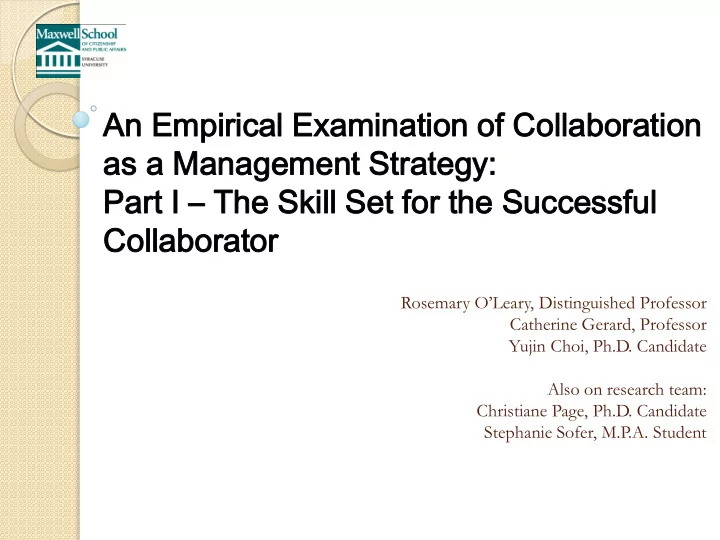

An Em n Empi pirica rical l Exami aminatio nation n of of Col olla laborati boration on as as a M a Man anag agem emen ent t Str trate ategy: gy: Par art t I I – The he Skill ill Set et fo for th the Suc e Successful cessful Col olla labo borator rator Rosemary O’Leary, Distinguished Professor Catherine Gerard, Professor Yujin Choi, Ph.D. Candidate Also on research team: Christiane Page, Ph.D. Candidate Stephanie Sofer, M.P.A. Student
The Larger Project Web-based survey of both career and non- career Senior Executive Service (SES) members in U.S. federal government Focus: Their use of collaboration as a management strategy 15 questions (13 open-ended; 2 yes/no) Defined term: ◦ Collaboration means to work across boundaries and in multi- organizational arrangements to solve problems that cannot be solved or easily solved by single organizations.
The Larger Project 305 usable surveys; 304 collaborators (biased results) Responses coded by 5 researchers ATLAS.ti. qualitative analysis ◦ (Qualitative) master hermeneutic unit and (quantitative) frequency count dataset
Importance SES Executive Core Qualification (2002): Building Coalitions Bush Management Agenda (2005) Obama Transparency and Collaboration Memo (2009) Understudied, important group ◦ Long tenure ◦ Standard setters ◦ Decisional authority
Profile Age : 46-55 Gender : 64% male; 36% female Education : Advanced degree (78%); college degree (20%) Location : Washington (69%). Status : Career senior executive service (90% ); appointed 8%
Focus of PRMC Paper People who engage in collaborations between or among organizations ------------- We asked: What is the skill set for the successful collaborator? Importance: Majority of literature on public management collaborations focuses on organizations, jurisdictions, and networks
Propositions #1 =Strategic management and visioning (Goldsmith & Eggers 2004; Milward & Provan 2006; McGuire & Silvia 2009) #2 = Facilitation, collaborative problem solving (Our “real world” work; Huxham et al 1993, 1996, 2000, 2004, 2005; Williams 2002; Crosby & Bryson 1992, McGuire & Silvia 2009; Silvia & McGuire 2010; Getha-Taylor 2008; Emerson & Smutco, forthcoming) #3 = Interpersonal skills (Our “real world” work; Getha - Taylor 2008 Silvia & McGuire 2010; Emerson & Smutco, forthcoming)
Findings What is the Skill Set of the Successful Collaborator? 300 250 200 150 100 50 0 Personal Attributes Interpersonal Skills Group Process Skills Strategic Leadership Substantive/Technical Expertise
Skill Set for the Successful Collaborator According to SES Respondents: #1 (tied) = Personal Attributes 90 80 70 60 50 40 30 20 10 0
Skill Set for the Successful Collaborator According to SES Respondents: #1 (tied) = Interpersonal Skills Good Communicator 120 100 80 60 40 20 0 Works Well With People Excellent Listener
Skill Set for the Successful Collaborator According to SES Respondents: # 3 = Group Process Skills Facilitation 45 40 Skill in Group Dynamics, 35 Interest-Based Negotiation Culture, Personalities 30 25 20 15 10 5 Collaborative Problem Compromise 0 Solving Mediation Conflict Resolution Consensus Building
Skill Set for the Successful Collaborator According to SES Respondents: # 4 = Strategic Leadership Big Picture Thinking 50 40 30 Sharing of Leadership, 20 Power, Goals, and Strategic Thinking Credit 10 0 Creative Approaches to Facilitative Leadership Problem Solving
Skill Set for the Successful Collaborator According to SES Respondents: # 5 = Substantive/T echnical Knowledge Technical Knowledge of Subject Area 40 35 30 25 20 15 10 5 0 Project Management & Time Management Organizational Skills
Does Collaboration Yield Conflict? Yes (63%) Approaches to Conflict in Collaboration: Conflict management (negotiation, compromise, interest-based problem solving) (81) Facilitation (eliciting common ground, voice, clarification of rules and goals) (92) “Let it happen” (37) Listening (27)
What are Catalysts to Collaboration? #1 = Relational Followed by: Opportunity for improvement Sense of urgency Mandate Organizational
What are the Challenges to Collaboration? #1 = Relational Followed by: Logistical Political Organizational Personal
Surprising Find #1 Contrast between why they collaborate (to increase performance) And What they report is needed to obtain that increase in performance (Traits)
Surprising Find #2 Common thread = emphasis on people and people skills throughout survey responses Skill Set Catalysts to collaboration Challenges to collaboration
Supports Work of Huxham et al, Williams, Getha-Taylor, Silvia & McGuire, Emerson and Smutco, and others EXCEPT for extent of emphasis on TRAITS
Supports Work of Goleman: Emotional Intelligence (EI) is the sine qua non of leadership; technical skills are threshold capabilities EXCEPT that SES told us: Strategic leadership (including visioning) and technical skills are important, but secondary variables for the successful collaborator
Next Week: Interviews Decouple strategic leadership and technical/substantive Investigate threshold versus non- threshold question Delve deeper into traits
Can Traits & Attributes of Successful Collaborators Be Taught? Goleman and others say yes (qualified) Certain people born with greater EI EI increases with age Coaching via incentives, videotaping, feedback; foreign country experience Rautalinko and Lisper (2004): training through modeling, then role-playing
Can Traits & Attributes of Successful Collaborators Be Taught? We say yes (qualified) Self-assessment long used at CCL, FEI, NTL Important = understanding of mental models & collaborative mindset O’Leary, Bingham, Choi (2010): course that teaches how to work collaboratively E-PARC free cases, simulations and syllabi on collaboration (www.e-parc.org)
Future Plans Using SES Data Additional exploration of the collaborative mindset Gender differences Differences across agencies Additional exploration of collaborative leadership IBM Report
Recommend
More recommend